Spatiotemporal Monitoring of the Effects of Climate Change on the Water Surface Area of Sidi Salem Dam, Northern Tunisia
Abstract
1. Introduction
2. Description of the Study Area
3. Materials and Methods
3.1. Data Collection
3.2. Satellite Image Processing
3.3. Multivariate Analysis
3.3.1. Normalized Difference Water Index (NDWI)
- Values close to +1 indicate open water;
- Values near 0 suggest bare soil or vegetation;
- Negative values represent dense vegetation or built-up areas.
3.3.2. Normalized Difference Vegetation Index (NDVI)
- Dense vegetation: 0.6;
- Moderate vegetation: 0.2 to 0.5;
- Sparse or no vegetation (bare soil, water): <0.1.
3.3.3. Normalized Difference Drought Index (NDDI)
- Higher values (>0.5) indicate severe drought or vegetation under water stress;
- Lower values (<0.2) suggest healthy vegetation and adequate moisture.
3.3.4. Normalized Difference Salinity Index (NDSI)
- Higher values suggest saline surfaces or soil;
- Lower values are typical of non-saline and vegetated areas.
3.3.5. Normalized Difference Turbidity Index (NDTI)
- Higher values indicate turbid;
- Lower or negative values indicate clear water.
3.3.6. Trend and Correlation Analysis
4. Results and Discussion
4.1. Normalized Difference Water Index (NDWI)
4.2. Normalized Difference Vegetation Index (NDVI)
4.3. Normalized Difference Water Index (NDDI)
4.4. Normalized Difference Turbidity Index (NDTI)
4.5. Normalized Difference Salinity Index (NDSI)
4.6. Trend and Correlation Analysis
5. Conclusions
- Climate modeling integration: coupling hydrological models with future climate scenarios can help predict long-term changes and support proactive decision-making.
- Socioeconomic impact analysis: future research should incorporate the socioeconomic impacts of dam shrinkage, especially on agriculture, drinking water supply, and local livelihoods.
- Restoration and resilience programs: encouraging ecosystem restoration in degraded upstream areas and investing in drought-resilient infrastructure will strengthen long-term water security.
- By combining remote sensing technology with sustainable planning, Tunisia can better navigate the challenges of climate change and ensure the resilience of its most important hydraulic assets, including the Sidi Salem Dam.
- Water quality monitoring: future studies should include measured salinity values and compare them with international (WHO) and national standards to provide a more practical evaluation of water quality degradation.
- Seasonal analysis: the monitoring of surface water during wet and dry seasons to assess changes in water levels, turbidity, and the dam’s regulation capacity.
Author Contributions
Funding
Data Availability Statement
Acknowledgments
Conflicts of Interest
References
- Wilhite, D.A. Drought as a Natural Hazard: Concepts and Definitions. In Drought: A Global Assessment; Wilhite, D., Ed.; Routledge: London, UK, 2000; Volume 1, pp. 3–18. [Google Scholar]
- Wilhite, D.A. Integrated drought management: Moving from managing disasters to managing risk. In Integrated Drought Management; CRC Press: Boca Raton, FL, USA, 2023; Volume 2, pp. 507–514. [Google Scholar]
- Khlifi, S.; Ameur, M.; Mtimet, N.; Ghazouani, N.; Belhadj, N. Impacts of small hill dams on agricultural development of hilly land in the Jendouba region of northwestern Tunisia. Agric. Water Manag. 2010, 97, 50–56. [Google Scholar] [CrossRef]
- Gader, K.; Gara, A.; Vanclooster, M.; Khlifi, S.; Slimani, M. Drought assessment in a south Mediterranean transboundary catchment. Hydrol. Sci. J. 2020, 65, 1300–1315. [Google Scholar] [CrossRef]
- Allani, M.; Mezzi, R.; Zouabi, A.; Béji, R.; Joumade-Mansouri, F.; Hamza, M.E.; Sahli, A. Impact of future climate change on water supply and irrigation demand in a small Mediterranean catchment. Case study: Nebhana dam system, Tunisia. J. Water Clim. Change 2020, 11, 1724–1747. [Google Scholar] [CrossRef]
- Mouelhi, S.; Kanzari, S.; Ben Mariem, S.; Zemni, N. Towards a Classification of Tunisian Dams for Enhanced Water Scarcity Governance: Parametric or Non-Parametric Approaches? Hydrology 2025, 12, 96. [Google Scholar] [CrossRef]
- Hill, J.; Woodland, W. Contrasting water management techniques in Tunisia: Towards sustainable agricultural use. Geogr. J. 2003, 169, 342–357. [Google Scholar] [CrossRef]
- Horchani, A. Water in Tunisia: A national perspective. In Agricultural Water Management: Proceedings of a Workshop in Tunisia; National Academies Press: Washington, DC, USA, 2007; p. 88. [Google Scholar]
- Gaaloul, N. Water resources and management in Tunisia. Int. J. Water 2011, 6, 92–116. [Google Scholar] [CrossRef]
- Hamed, Y.; Ayadi, Y.; Hadji, R.; Ben Saad, A.; Gentilucci, M.; Elaloui, E. Environmental Radioactivity, Ecotoxicology (238U, 232Th and 40K) and Potentially Toxic Elements in Water and Sediments from North Africa Dams. Sustainability 2024, 16, 490. [Google Scholar] [CrossRef]
- Ayadi, Y.; Gentilucci, M.; Ncibi, K.; Hadji, R.; Hamed, Y. Assessment of a Groundwater Potential Zone Using Geospatial Artificial Intelligence (Geo-AI), Remote Sensing (RS), and GIS Tools in Majerda Transboundary Basin (North Africa). Water 2025, 17, 331. [Google Scholar] [CrossRef]
- Zahar, Y.; Ghorbel, A.; Albergel, J. Impacts of large dams on downstream flow conditions of rivers: Aggradation and reduction of the Medjerda channel capacity downstream of the Sidi Salem dam (Tunisia). J. Hydrol. 2008, 351, 318–330. [Google Scholar] [CrossRef]
- Japan International Cooperation Agency (JICA). Republic of Tunisia the Preparatory Survey on Sidi Salem Multi-Purpose Dam Comprehensive Sedimentation Management Project. Final Report. 2023, p. 251. Available online: https://openjicareport.jica.go.jp/pdf/12385266.pdf (accessed on 6 August 2025).
- Bernhardt, H. Pronostics sur la Qualité de l’eau Dans le Barrage de Sidi Salem, Tunisie. Deuxième Partie; Coopération Technique Tuniso-Allemande: Tunis, Tunisia, 1978; 237p. [Google Scholar]
- World Imagery, Esri, DigitalGlobe, GeoEye, I-Cubed, USDA FSA, USGS, AEX, Getmapping, Aerogrid, IGN, IGP, Swisstopo, and the GIS User Community. Available online: https://www.arcgis.com/home/item.html?id=10df2279f9684e4a9f6a7f08febac2a9 (accessed on 12 December 2009).
- Hentati, A. Modélisation de la qualité des eaux de Sidi Salem. Master Thesis, National School of Engineering of Tunisia (ENIT), Tunis, Tunisia, 2003; 120p. [Google Scholar] [CrossRef]
- National Aeronautics and Space Administration (NASA). POWER Data Access Viewer, Single Point Data Access. 2025. Available online: https://power.larc.nasa.gov/data-access-viewer/ (accessed on 1 March 2025).
- Ayadi, Y.; Mokadem, N.; Besser, H.; Khelifi, F.; Harabi, S.; Hamad, A.; Boyce, A.; Laouar, R.; Hamed, Y. Hydrochemistry and stable isotopes (δ18O and δ2H) applied to the study of karst aquifers in the Southern Mediterranean Basin (Teboursouk area, NW Tunisia). J. Afr. Earth Sci. 2017, 137, 208–217. [Google Scholar] [CrossRef]
- Bannour, H.; Bonvallot, J. Les dépôts quaternaires de la vallée de la Medjerda dans la «zone des diapirs», témoins de déformations quaternaires continues. Méditerranée 1988, 64, 7–11. [Google Scholar] [CrossRef]
- El Ouardi, H. Origine des variations latérales des dépôts yprésiens dans la zone des dômes en Tunisie septentrionale. Comptes Rendus. Géoscience 2002, 334, 141–146. [Google Scholar] [CrossRef]
- Ayadi, Y.; Mokadem, N.; Khelifi, F.; Khalil, R.; Dhawadi, L.; Hamed, Y. Groundwater potential recharge assessment in Southern Mediterranean basin using GIS and remote sensing tools: Case of Khalled Teboursouk basin, karst aquifer. Appl. Geomat. 2024, 16, 677–693. [Google Scholar] [CrossRef]
- Ayadi, Y.; Mokadem, N.; Besser, H.; Redhaounia, B.; Khelifi, F.; Harabi, S.; Nasri, T.; Hamed, Y. Statistical and geochemical assessment of groundwater quality in the Teboursouk area (Northwestern Tunisian Atlas). Environ. Earth Sci. 2018, 77, 349. [Google Scholar] [CrossRef]
- Mattoussi, W.; Mattoussi, F.; Zeddini, Y. Does dam-based irrigation affect the sustainability of natural capital?: A doubly robust analysis. J. Clean. Prod. 2024, 450, 141764. [Google Scholar] [CrossRef]
- ONAGRI. National Water Sector Report; Ministry of Agriculture, Water Resources and Fisheries, internal report; ONAGRI: Tunis, Tunisia, 2020. [Google Scholar]
- Sawassi, A.; Khadra, R.; Crookston, B. Water Banking as a Strategy for the Management and Conservation of a Critical Resource: A Case Study from Tunisia’s Medjerda River Basin (MRB). Sustainability 2024, 16, 3875. [Google Scholar] [CrossRef]
- Rhili, H. The World Bank’s Water and Sanitation Policies in Tunisia. Transnational Institute. 2024. Available online: https://www.tni.org/en/article/the-world-banks-water-and-sanitation-policies-in-tunisia (accessed on 1 March 2025).
- Chebil, A.; Souissi, A.; Frija, A.; Stambouli, T. Estimation of the economic loss due to irrigation water use inefficiency in Tunisia. Environ. Sci. Pollut. Res. 2019, 26, 11261–11268. [Google Scholar] [CrossRef]
- U.S. Geological Survey, Earth Explorer. Satellite Data. 2025. Available online: https://earthexplorer.usgs.gov/ (accessed on 1 March 2025).
- U.S. Geological Survey, Landsat Satellite Missions. 2025. Available online: https://www.usgs.gov/landsat-missions/landsat-satellite-missions (accessed on 1 March 2025).
- Gao, B.C. NDWI—A normalized difference water index for remote sensing of vegetation liquid water from space. Rem. Sens. Environ. 1998, 58, 257–266. [Google Scholar] [CrossRef]
- Tucker, C.J. Red and Photographic Infrared Linear Combinations for Monitoring Vegetation. Rem. Sens. Environ. 1979, 8, 127–150. [Google Scholar] [CrossRef]
- Gu, Y.; Brown, J.F.; Verdin, J.P.; Wardlow, B. A five-year analysis of Modis Ndvi and NDWI for grassland drought assessment over the central Great Plains of the United States. Geophys. Res. Lett. 2007, 34, 6. [Google Scholar] [CrossRef]
- McFEETERS, S.K. The use of the Normalized Difference Water Index (NDWI) in the delineation of open water features. Int. J. Remote Sens. 1996, 17, 1425–1432. [Google Scholar] [CrossRef]
- Du, Z.; Li, W.; Zhou, D.; Tian, L.; Ling, F.; Wang, H.; Gui, Y.; Sun, B. Analysis of Landsat-8 OLI imagery for land surface water mapping. Remote Sens. Lett. 2024, 5, 672–681. [Google Scholar] [CrossRef]
- Ashok, A.; Rani, H.P.; Jayakumar, K.V. Monitoring of dynamic wetland changes using NDVI and NDWI based landsat imagery. Remote Sens. Appl. Soc. Environ. 2021, 23, 100547. [Google Scholar] [CrossRef]
- Khan, N.M.; Rastoskuev, V.V.; Sato, Y.; Shiozawa, S. Assessment of hydrosaline land degradation by using a simple approach of remote sensing indicators. Agric. Water Manag. 2005, 77, 96–109. [Google Scholar] [CrossRef]
- Bid, S.; Siddique, G. Identification of seasonal variation of water turbidity using NDTI method in Panchet Hill Dam, India. Model. Earth Syst. Environ. 2019, 5, 1179–1200. [Google Scholar] [CrossRef]
- Mann, B.H. Nonparametric Tests Against Trend. Econometrica 1945, 13, 245–259. [Google Scholar] [CrossRef]
- Kendall, M.G. Rank Correlation Measures; Charles Griffin: London, UK, 1975. [Google Scholar]
- Profillidis, V.A.; Botzoris, G.N. Chapter 5—Statistical Methods for Transport Demand Modeling. Model. Transp. Demand 2019, 1, 163–224. [Google Scholar] [CrossRef]
- Lahmar, L. Approche multi-temporelle et systémique du risque d’inondation dans le bassin fluvial moyen de l’oued Medjerda (Tunisie septentrionale). Ph.D. Thesis, Université Paris Cité, Paris, France, 2021. [Google Scholar]
- Mammou, A.B.; Louati, M.H. Évolution temporelle de l’envasement des retenues de barrages de Tunisie. Rev. Des Sci. De L’eau 2007, 20, 201–210. [Google Scholar]
- Mlayah, A.; Da Silva, E.F.; Rocha, F.; Hamza, C.B.; Charef, A.; Noronha, F. The Oued Mellègue: Mining activity, stream sediments and dispersion of base metals in natural environments, North-western Tunisia. J. Geochem. Explor. 2009, 102, 27–36. [Google Scholar] [CrossRef]
- Romdhane, S.B.; El Bour, M.; Hamza, A.; Akrout, F.; Kraiem, M.M.; Jacquet, S. Seasonal patterns of viral, microbial and planktonic communities in Sidi Salem: A freshwater reservoir (North of Tunisia). In Annales de Limnologie-International Journal of Limnology; EDP Sciences: Les Ulis, France, 2014; Volume 50, pp. 299–314. [Google Scholar]
- Mili, S.; Ennouri, R.; Laouar, H.; Romdhane, N.B.; Missaoui, H.; Daaloul-Jedidi, M.; Soudani, A.; Messadi, L. Etude des peuplements piscicoles de la retenue du barrage de Sidi Salem. J. New Sci. 2016, 27, 1. [Google Scholar]
- Kotti, F.; Dezileau, L.; Mahé, G.; Habaieb, H.; Benabdallah, S.; Bentkaya, M.; Calvez, R.; Dieulin, C. Impact of dams and climate on the evolution of the sediment loads to the sea by the Mejerda River (Golf of Tunis) using a paleo-hydrological approach. J. Afr. Sci. 2018, 142, 226–233. [Google Scholar] [CrossRef]
- Helali, M.A.; Ouameni, I.; Ben Mna, H.; Mesnage, V.; Souissi, R.; Kouka, A.; Oueslati, W. Assessing porewater and sediment quality in the Sidi Salem Dam: Insights from an artificial aquatic geosystem in Tunisia. J. Sediment. Environ. 2025, 10, 373–385. [Google Scholar] [CrossRef]
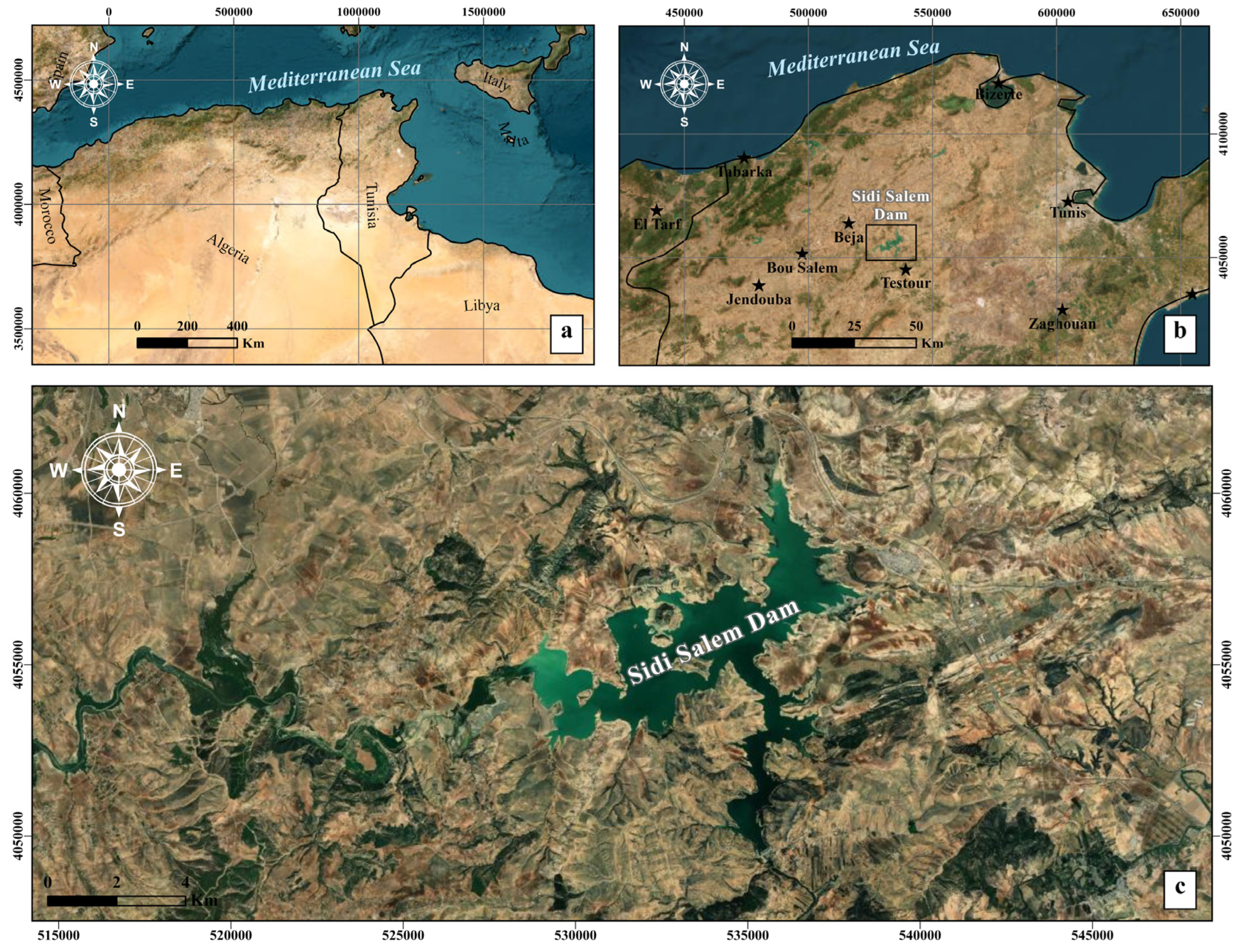




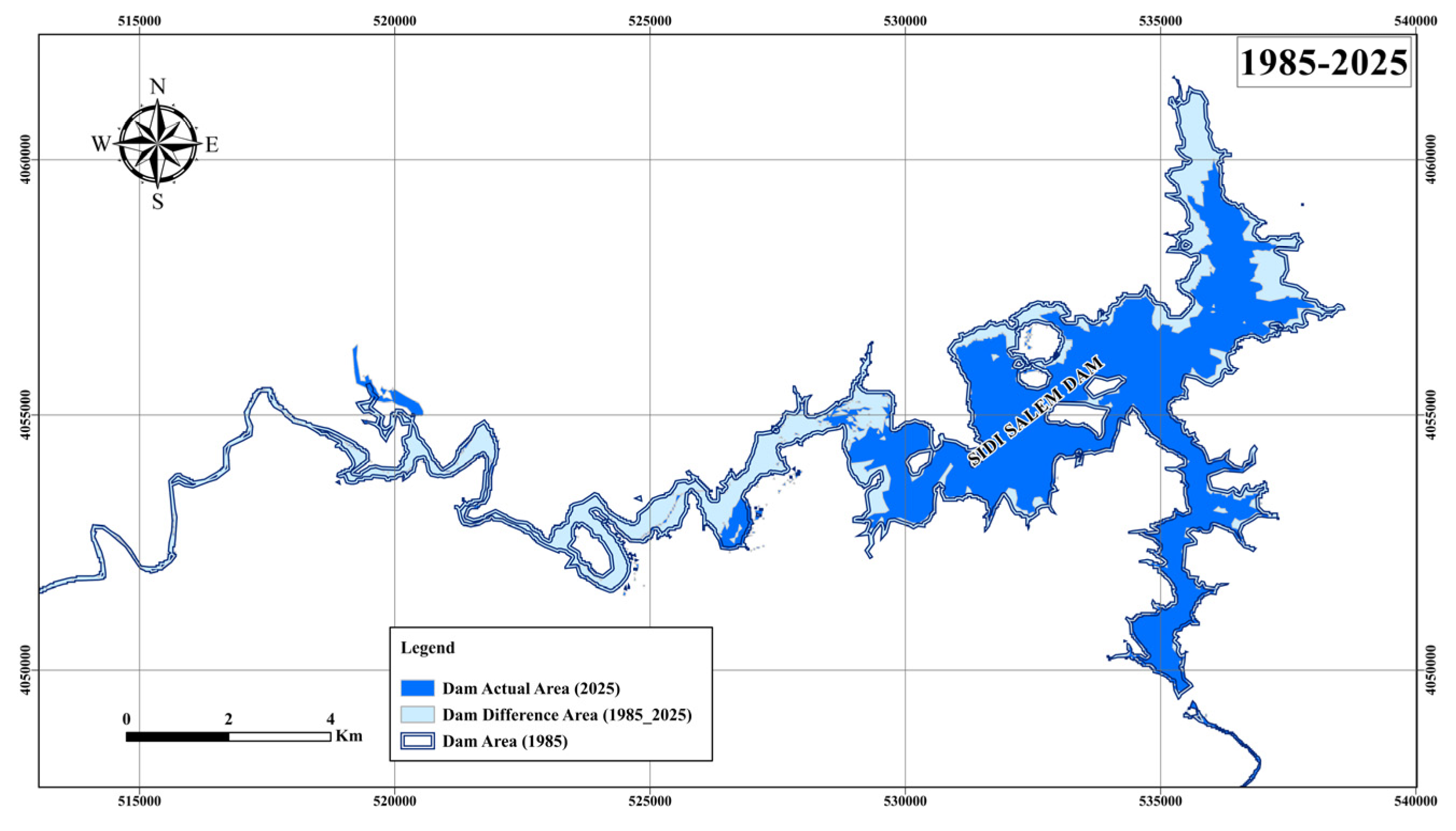



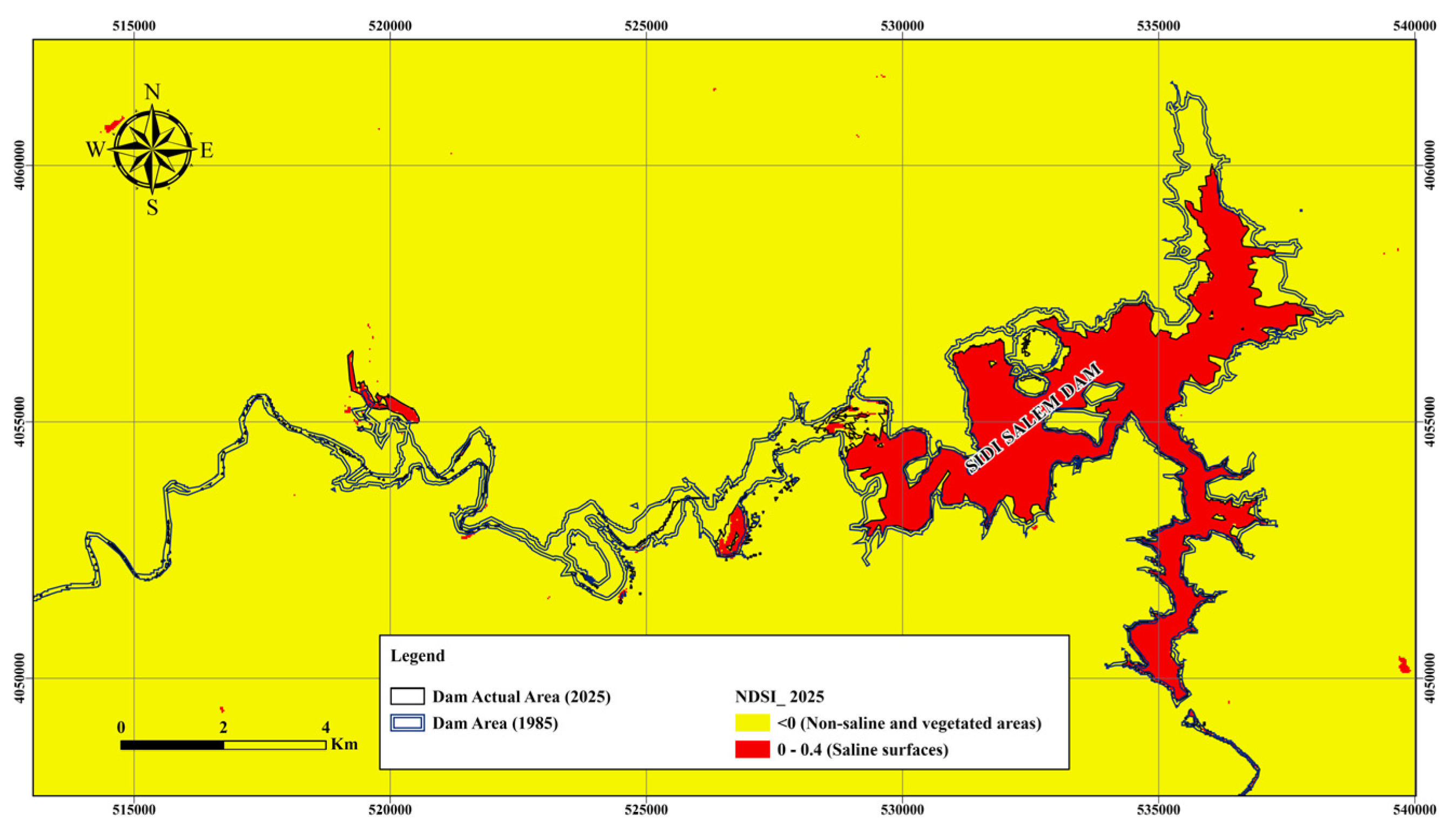
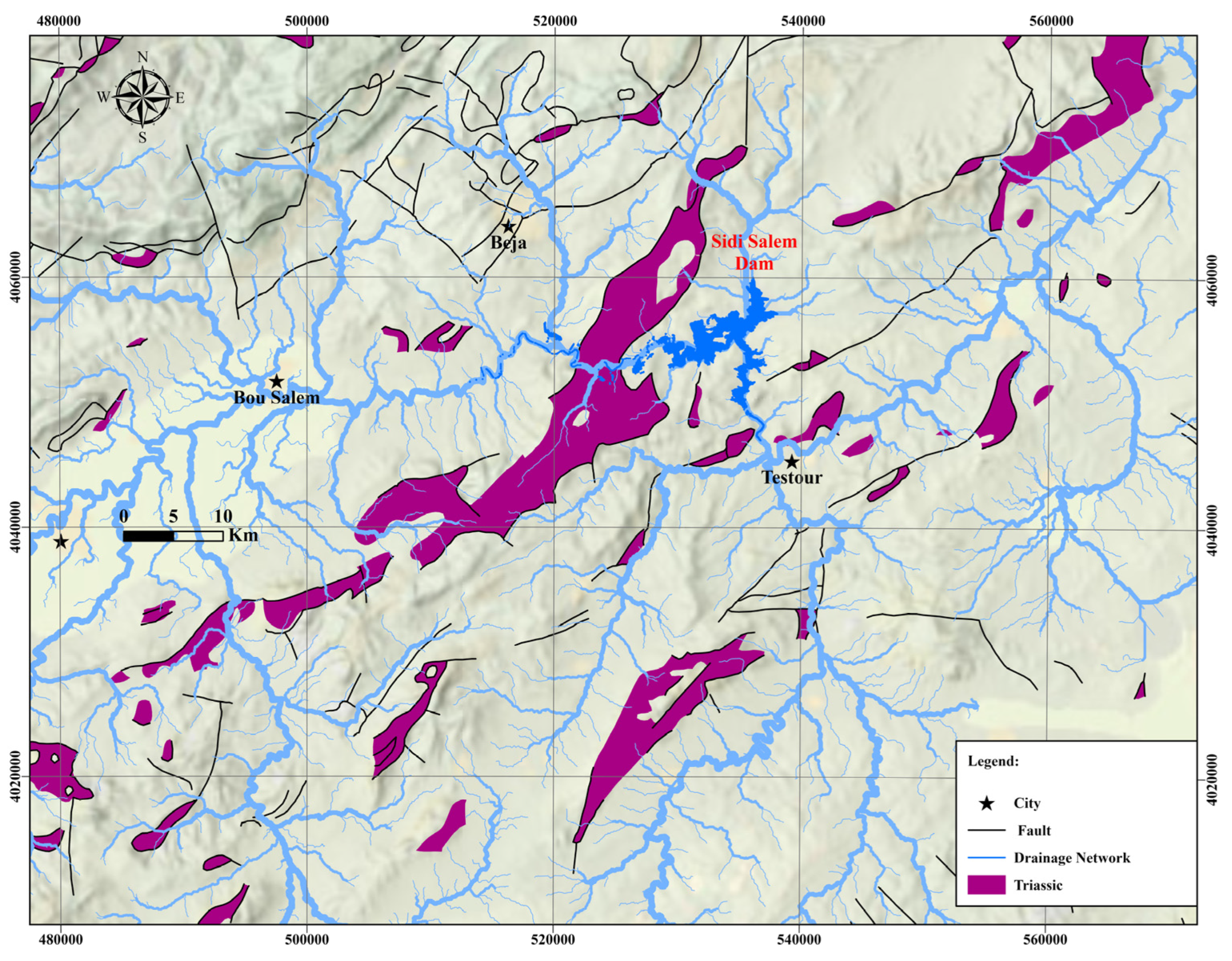
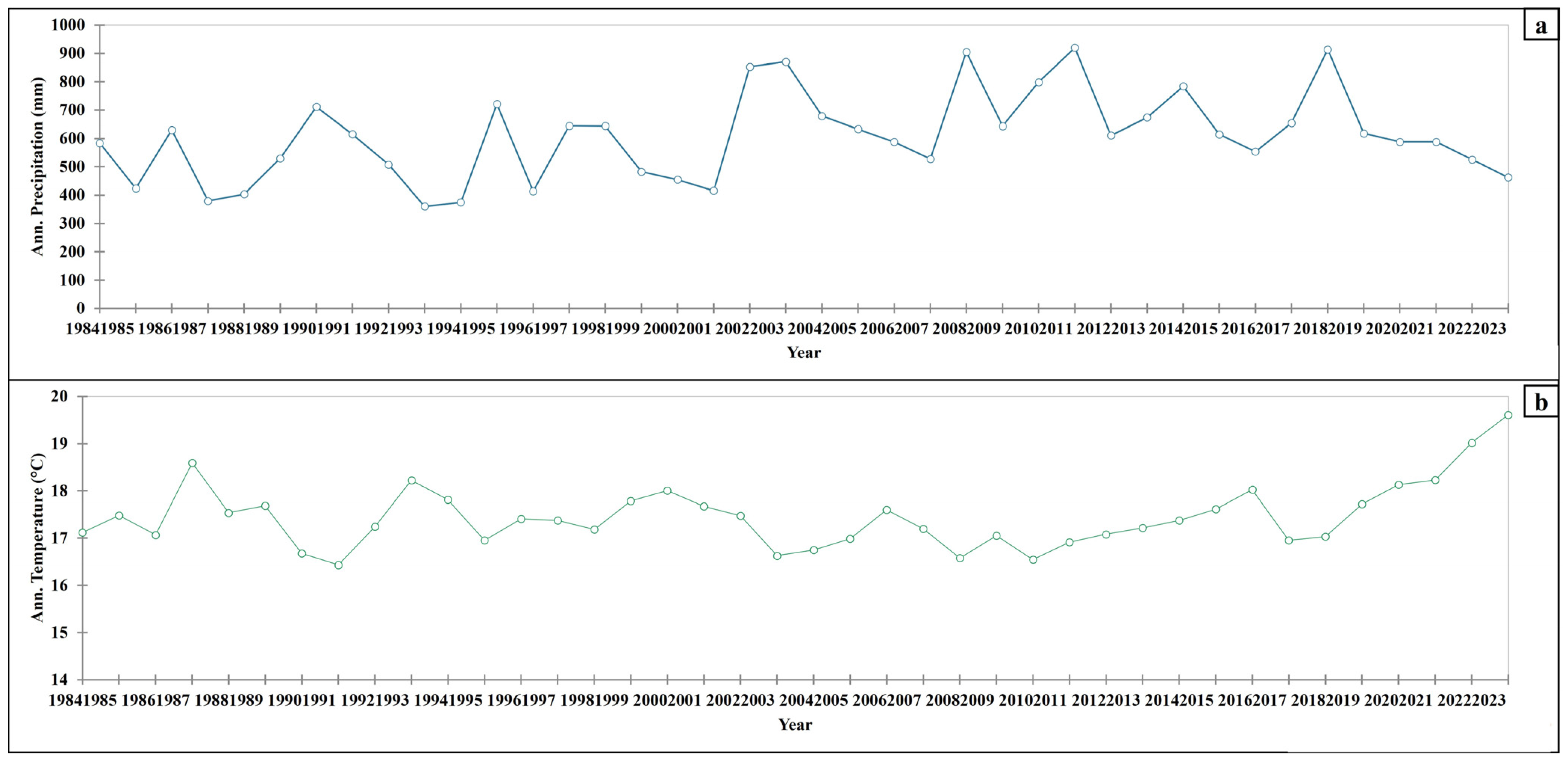
| Satellite | Date | Path/Row | Wavelengths (μm) |
|---|---|---|---|
| Landsat-5 TM | 18 April 1985 | 192/035 | Band 1 Visible Blue (0.45–0.52 µm) Band 2 Visible Green (0.52–0.60 µm) Band 3 Visible Red (0.63–0.69 µm) Band 4 Near-Infrared (0.76–0.90 µm) Band 5 Near-Infrared (1.55–1.75 µm) Band 6 Thermal (10.40–12.50 µm) Band 7 Mid-Infrared (2.08–2.35 µm) |
| Landsat-9 OLI/TIRS | 10 April 2025 | 192/035 | Band 1 Visible Coastal Aerosol (0.43–0.45 µm) Band 2 Visible Blue (0.450–0.51 µm) Band 3 Visible Green (0.53–0.59 µm) Band 4 Red (0.64–0.67 µm) Band 5 Near-Infrared (0.85–0.88 µm) Band 6 SWIR 1(1.57–1.65 µm) Band 7 SWIR 2 (2.11–2.29 µm) Band 8 Panchromatic (PAN) (0.50–0.68 µm) Band 9 Cirrus (1.36–1.38 µm) Band 10 TIRS 1 (10.6–11.19 µm) Band 11 TIRS 2 (11.5–12.51 µm) |
| Series\Test | Kendall’s Tau | S’ | Var(S’) | p-Value | Alpha | Sen’s Slope |
|---|---|---|---|---|---|---|
| Ann. Precipitation | 0.500 | 18 | 44.000 | 0.010 | 0.05 | 94.035 |
| Ann. Temperature | −0.278 | −10 | 44.000 | 0.175 | 0.05 | −0.233 |
| Variables | Ann. Precipitation | Ann. Temperature |
|---|---|---|
| Ann. Precipitation | 1 | −0.601 |
| Ann. Temperature | −0.601 | 1 |
Disclaimer/Publisher’s Note: The statements, opinions and data contained in all publications are solely those of the individual author(s) and contributor(s) and not of MDPI and/or the editor(s). MDPI and/or the editor(s) disclaim responsibility for any injury to people or property resulting from any ideas, methods, instructions or products referred to in the content. |
© 2025 by the authors. Licensee MDPI, Basel, Switzerland. This article is an open access article distributed under the terms and conditions of the Creative Commons Attribution (CC BY) license (https://creativecommons.org/licenses/by/4.0/).
Share and Cite
Ayadi, Y.; Abbes, M.; Gentilucci, M.; Hamed, Y. Spatiotemporal Monitoring of the Effects of Climate Change on the Water Surface Area of Sidi Salem Dam, Northern Tunisia. Water 2025, 17, 2738. https://doi.org/10.3390/w17182738
Ayadi Y, Abbes M, Gentilucci M, Hamed Y. Spatiotemporal Monitoring of the Effects of Climate Change on the Water Surface Area of Sidi Salem Dam, Northern Tunisia. Water. 2025; 17(18):2738. https://doi.org/10.3390/w17182738
Chicago/Turabian StyleAyadi, Yosra, Malika Abbes, Matteo Gentilucci, and Younes Hamed. 2025. "Spatiotemporal Monitoring of the Effects of Climate Change on the Water Surface Area of Sidi Salem Dam, Northern Tunisia" Water 17, no. 18: 2738. https://doi.org/10.3390/w17182738
APA StyleAyadi, Y., Abbes, M., Gentilucci, M., & Hamed, Y. (2025). Spatiotemporal Monitoring of the Effects of Climate Change on the Water Surface Area of Sidi Salem Dam, Northern Tunisia. Water, 17(18), 2738. https://doi.org/10.3390/w17182738








